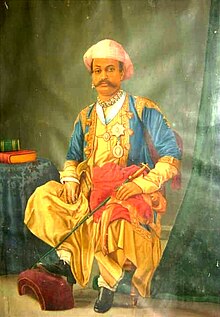
Back ইন্দোর রাজ্য Bengali/Bangla Indore Catalan Indore (Staat) German État d'Indore French इन्दौर रियासत Hindi Negara Indore ID Indore (stato) Italian इंदूर संस्थान Marathi Negara Indore Malay ਇੰਦੌਰ ਰਿਆਸਤ Punjabi
22°43′31″N 75°51′56″E / 22.7252°N 75.8655°E
Indore State Indūra rājya | |||||||||
|---|---|---|---|---|---|---|---|---|---|
| 1732–1948 | |||||||||
 | |||||||||
| Status | State Within the Maratha Confederacy (1731–1818) Protectorate of the East India Company (1818–1857) Princely State of the British Raj (1857–1947) State of the Dominion of India (1947–1948) | ||||||||
| Capital | Indore | ||||||||
| Raja | |||||||||
• 1732–1766 (first) | Malhar Rao Holkar | ||||||||
• 1926–1948 (last) | Yashwant Rao Holkar II | ||||||||
| History | |||||||||
• Established | 29 July 1732 | ||||||||
• Accession to Dominion of India | 1 January 1948 | ||||||||
| Area | |||||||||
| 1931 | 25,646 km2 (9,902 sq mi) | ||||||||
| Population | |||||||||
• 1931 | 13,25,089 | ||||||||
| |||||||||
| Today part of | India ∟ Madhya Pradesh | ||||||||









Indore State, also known as Holkar State,[1] was a kingdom in India. Its rulers belonged to the Maratha Holkar dynasty.[2] After 1857, Indore became a 19-gun salute princely state under the British Raj.
Indore State was located in the present-day Indian state of Madhya Pradesh, with its capital at the city of Indore. The state had an area of 24,605 km2 and a population of 1,325,089 in 1931. Other important towns besides Indore were Rampura, Khargone, Maheshwar, Mehidpur, Barwaha, and Bhanpura; there were a total of 3,368 villages.[3]
- ^ Princely States of India
- ^ Cotton, James Sutherland (1911). . In Chisholm, Hugh (ed.). Encyclopædia Britannica. Vol. 14 (11th ed.). Cambridge University Press. pp. 500–501.
- ^ Great Britain India Office. The Imperial Gazetteer of India. Oxford: Clarendon Press, 1908.


